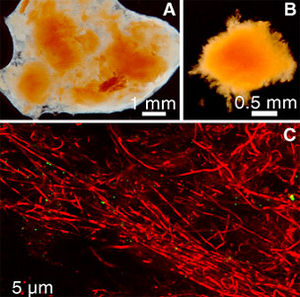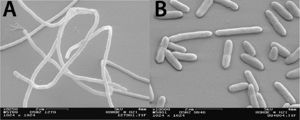Meiothermus: Difference between revisions
| Line 54: | Line 54: | ||
''Meiothermus'', is a Gram-negative, aerobic microorganism that is variable in length and often forms short filaments. It is primarily an oxygenic chemoorganoheterotroph, but some species grow with nitrate as the terminal electron acceptor. As such, it utilizes such organic substrates such as starch, hexoses, pentoses, disaccharides, amino acids, and organic acids as both a carbon and energy source. The optimum growth conditions varies in a moderate temperature range (50-65°C) and alkaline environments (pH ~8.0). | ''Meiothermus'', is a Gram-negative, aerobic microorganism that is variable in length and often forms short filaments. It is primarily an oxygenic chemoorganoheterotroph, but some species grow with nitrate as the terminal electron acceptor. As such, it utilizes such organic substrates such as starch, hexoses, pentoses, disaccharides, amino acids, and organic acids as both a carbon and energy source. The optimum growth conditions varies in a moderate temperature range (50-65°C) and alkaline environments (pH ~8.0). | ||
Its common red-orange appearance stems from the production of carotenoids via the metabolism of tepernoids and polyketides []. The ability of thermophilic bacteria much like those from the genus ''Meiothermus'' to withstand high temperatures are thought to stem from the possession of special mechanisms for membrane stabilization. Carotenoid production may be one of the mechanisms that these bacteria possess, based on the length of carotenoid molecules and its analogue to the fatty acids of the lipid bilayer. | Its common red-orange appearance stems from the production of carotenoids via the metabolism of tepernoids and polyketides []. The ability of thermophilic bacteria much like those from the genus ''Meiothermus'' to withstand high temperatures are thought to stem from the possession of special mechanisms for membrane stabilization. Carotenoid production may be one of the mechanisms that these bacteria possess, based on the length of carotenoid molecules and its analogue to the fatty acids of the lipid bilayer []. | ||
Revision as of 17:57, 17 April 2011

Classification
Domain: Bacteria, Phylum: Deinococcus-Thermus, Class: Deinococci, Order: Thermales, Family: Thermaceae
Species
|
NCBI: Taxonomy |
- Meiothermus chiliarophilus
- Meiothermus cerbereus
- Meiothermus granaticius
- Meiothermus rosaceus
- Meiothermus ruber
- Meiothermus rufus
- Meiothermus silvanus
- Meiothermus taiwanensis
- Meiothermus timidus
Description and Significance

Before the recognition of the genus Meiothermus, the species under the genus Thermus were designated as either high or low-temperature species. The proposal of a new genus Meiothermus in 1996 was made to designate the phylogenetic, phenotypic, and chemotaxonomic distinctiveness of the species that have low optimum growth temperatures. Meiothermus indicates an organism living in a "less-hot" place [1]. The cells are 0.5 to 0.8 μm in diameter and cell length is variable - often forming short filaments. The colonies that form vary from red to yellow pigment and are often found in hydrothermal vents.
Describe the appearance, habitat, etc. of the organism, and why you think it is important.
Genome Structure
The entire genome of Meiothermus silvanus DSM 9946 has been sequenced and consist of a 3,249,394 bp long circular chromosome and two plasmids of 347,854 bp and 124,421 bp lengths, respectively [2].
Describe the size and content of the genome. How many chromosomes? Circular or linear? Other interesting features? What is known about its sequence?
Cell Structure, Metabolism and Life Cycle

Meiothermus, is a Gram-negative, aerobic microorganism that is variable in length and often forms short filaments. It is primarily an oxygenic chemoorganoheterotroph, but some species grow with nitrate as the terminal electron acceptor. As such, it utilizes such organic substrates such as starch, hexoses, pentoses, disaccharides, amino acids, and organic acids as both a carbon and energy source. The optimum growth conditions varies in a moderate temperature range (50-65°C) and alkaline environments (pH ~8.0).
Its common red-orange appearance stems from the production of carotenoids via the metabolism of tepernoids and polyketides []. The ability of thermophilic bacteria much like those from the genus Meiothermus to withstand high temperatures are thought to stem from the possession of special mechanisms for membrane stabilization. Carotenoid production may be one of the mechanisms that these bacteria possess, based on the length of carotenoid molecules and its analogue to the fatty acids of the lipid bilayer [].
Interesting features of cell structure; how it gains energy; what important molecules it produces.
Ecology and Pathogenesis
Habitat; symbiosis; biogeochemical significance; contributions to environment.
If relevant, how does this organism cause disease? Human, animal, plant hosts? Virulence factors, as well as patient symptoms.
References
[2] NCBI genome sequence for Meiothermus genus
[] Kanehisa Laboratories. "Carotenoid biosynthesis - Meiothermus ruber". 2011.
Author
Page authored by Michael Huarng and Steven Huynh, student of Prof. Jay Lennon at Michigan State University.
<-- Do not remove this line-->
